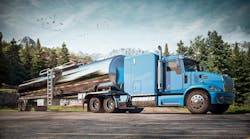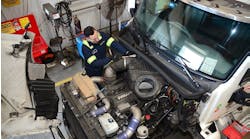Idling an engine for a long duration can lead to increased maintenance costs and shorten engine life, as well as increase fuel use. In heavy duty trucking applications, however, idling is often necessary and inevitable because of important factors like driver comfort in extreme weather conditions or powering emergency lighting, radios and other equipment during necessary downtime.
While fleets can't always eliminate the problem completely, there are ways to reduce idling. Enter: Idling Reduction Technologies (IRTs).
IRTs allow vehicle operators to shut down or reduce power to the main engine and instead use an alternate system to supply power or services that usually require the main drive engine. These devices are either installed on the vehicle or where the vehicle is parked, and most require minimal maintenance to operate efficiently.
The U.S. Environmental Protection Agency (EPA) recognizes fives types of IRTs, four on-board devices and one off-board technology, which have been verified to reduce emissions on Class 8 trucks compared to their baseline emissions.
Once installed on a truck, it is a best practice for a fleet to perform a daily inspection of their chosen IRT system, making sure air flow is not blocked, the assembly is clean and free of debris and obstructions and that all electrical connections are free of corrosion.
The four on-board IRT devices are:
1.Auxiliary power units
An auxiliary power unit (APU) is a vehicle-mounted portable system which supplies a complete solution of cooling, heating and electrical power. These systems commonly have a small diesel internal combustion engine with a generator, but can also be battery-powered.
Some APU units, like Carrier Transicold’s EPA SmartWay verified ComfortPro for example, also offer wayside-power compatibility which allows the units to plug into available infrastructure instead of being powered by diesel fuel.
Diesel APUs are well-suited for fleet operations in extreme temperatures and those needing to provide driver comfort for long periods of time.
While APUs are the most comprehensive idle reduction solution of all IRTs, they also require the most upfront cost to install and require regular maintenance, according to the North American Council for Freight Efficiency (NACFE)’s Idle Reduction Confidence Report. Therefore, they are recommended for fleets who can accommodate shortened maintenance intervals.
Diesel APUs require common maintenance practices such as inspecting wire harness bundles to ensure they are secure, cleaning and tightening electrical connections and periodically replacing the return air filter, Thermo King’s APU Product Manager Steve DeLarosby recommends. A business unit of Ingersoll Rand, Thermo King manufactures temperature control systems for trucks and trailers.
“Similar to other diesel engines, periodic maintenance such as changing the oil, filters and belts are required for a diesel APU,” DeLarosby says. “Battery APUs will not have these types of maintenance requirements, but the savings are offset by necessary periodic battery replacements.”
Recommended intervals for changing engine oil, oil filters, fuel filters and air filters vary from 500 to 2,000 hours, depending on the manufacturer.
Greg Bremhorst, director of power systems for Phillips & Temro, a manufacturer of electric APUs, says performing preventive maintenance twice a year is important.
“It’s a relatively simple process of checking the mounting hardware, tightening and cleaning battery connections, cleaning the evaporator filter and checking and replacing the thermostat battery plus a few other steps,” Bremhorst says.
Because APUs have many components to maintain, accessibility of these units is a priority. For this reason, a major objective in designing APUs is to improve serviceability.
Thermo King kept that in mind with its most recent update for its EPA SmartWay verified TriPac Evolution diesel APU.
“The external skins were completely redesigned so that the unit is easy to access for common maintenance practices, and with significantly less fasteners,” DeLarosby says. “Non-rusting materials such as stainless steel and aluminum are used to ensure ease of disassembly. Converting from steel skins to aluminum and creating pivot points for the bottom access pan makes the job easy for technicians. And finally, components like the fuel pump pre-filter are relocated on the powerpack to provide simple access for maintenance.”
Similarly, after Carrier Transicold acquired the ComfortPro diesel APUs product line in 2017, the company included design upgrades on the latest generation to reduce maintenance and “double the length of time between service.”
“A new automotive style multi-V drive belt is among the latest enhancements, as well as a tensioner that automatically adjusts the belt to help maintain full voltage output of the generator when the APU is running,” says Ryan Rubly, Carrier Transicold’s alternative power product manager. “This eliminates manual belt tensioning, periodically required with earlier models. Also, the system now uses high-performance CK-4 heavy duty engine oil, enabling the maintenance interval to be extended from 1,000 to 2,000 hours.”
2. Fuel operated heaters
Fuel operated heaters (FOH), sometimes referred to as direct fired heaters (DFH), are small heaters that burn fuel from the main engine fuel supply or a separate fuel reserve. They provide heat and can be used in conjunction with cooling systems depending upon the cab comfort needs.
These on-board heaters heat either air in the cab or bunk, or coolant that pumps through the engine in order to keep the engine warm and diesel fuel at a lower viscosity.
Air heaters help reduce operating costs through fuel savings, reduced engine wear and extended maintenance intervals while maintaining bunk heat. Driver comfort is also improved by eliminating idling, and therefore eliminating vibration and engine noise, as well as improving air quality.
Heating coolant also effectively reduces the impact of cold starts and cold-weather gelling of diesel fuel. Fuel operated coolant heaters, like Eberspaecher Climate Control System’s EPA SmartWay Verified Hydronic D5 E, for example, provide engine preheat for “improved start-ability,” says Eberspaecher’s Vice President of Marketing John Dennehy.
“Fleets have seen great success in pre-heating the engine year-round to reduce emissions on start-up,” says Josh Lupu, director of marketing for Webasto Thermo & Comfort North America. “Testing has shown as much as a 66 percent reduction in particulate matter at engine startup. This dramatically increases DPF [diesel particulate filter] performance by reducing filter clogging and overloading. Pre-heating the engine also brings the engine up to operating temperature quickly which helps the exhaust reach the needed temperature for DPF regeneration.
“Even in 90 degree F ambient temperatures, an engine still isn’t at optimum operating temperature – so engine pre-heating is still effective. Fleets in southern states are seeing dramatic increases in DPF performance by pre-heating their engines,” Lupu says.
Webasto is a manufacturer of heavy duty heating systems like coolant and air heaters.
To keep the internal components of an air or coolant heater active and moving, Eberspacher’s Dennehy recommends running the heater for at least 15 minutes every month.
Heaters can sometimes slip to the bottom of the preventive maintenance list in summer months, but Dennehy says it’s important to keep all components active throughout the year to prevent “spiders and other critters” from creating blockage through the exhaust system. Because the system operates by moving air through the heater, known as air throughput, it’s essential to ensure the ducts are not restricted integrally, or in the space around it.
Dennehy also recommends cleaning the glow pin and glow pin screen every six months to prevent carbon buildup on the pin.
“This creates a much cleaner ignition process,” explains Dennehy.
In addition, Dennehy also recommends shielding heaters from winter conditions.
“Keeping heaters in boxes or tucked away in frame rails is a good idea,” he says. “This keeps the salt and slush remnants from entering the intake and exhaust tubes.”
In general, both air and coolant heaters work similarly and therefore have similar upkeep requirements.
To learn what to look for when conducting a visual inspection of fuel operated heaters, view the following videos: VehicleServicePros.com/21013217 (air heaters) and VehicleServicePros.com/21013219 (coolant heaters
3. Battery air conditioning systems
Battery Air Conditioning (BAC) systems are a true zero-idle solution which use separate batteries to power an electric cooling system without any help from the engine.
“These systems are economical to operate because reduced idle time means less money spent on fuel and diesel exhaust fluid (DEF), which helps alleviate diesel particulate filter (DPF) clogging,” explains Sean Connell, technical director of Bergstrom’s no-idle products. Bergstrom is a manufacturer of cab climate systems for commercial trucks.
These battery operated heating and/or cooling systems can be integrated with a fuel-operated heater to supply heating, however they will consume diesel fuel during heater operation to run in that way.
Compared to more complex engine-driven APU systems, BACs require very little maintenance besides inspections for corrosion or tightness of connections to prevent voltage drops.
General system cleaning is also an annual necessity for battery-operated cooling systems, Connell recommends. In addition, batteries should be inspected for dirt and loose connections at every preventative maintenance interval. If dirty or loose, all connections should be disconnected and cleaned gently, then securely tightened and lubricated with dielectric grease.
Some units, like Bergstrom’s EPA SmartWay Verified NITE Phoenix and NITE SSI products for example, are equipped with a battery monitoring system which provides battery health information and maintenance notifications, like alerting when filters need to be cleaned, to keep fleets informed on the status of systems.
“If cleaning is indicated, the NITE unit filter should be pulled, inspected and cleaned as needed,” Connell says. The typical timeframe for cleaning filters is every 500 hours of run-time.
As for the condenser cleaning, Connell recommends rinsing it with “light soapy water with a soft spray from a garden hose, not a high-pressure sprayer.”
Bergstrom also offers a mobile app, NITE Phoenix No Idle Controller, for its NITE Phoenix family of products. The app provides up-to-date technical service manuals for any fault codes that may occur, as well as a remote control system to pre-condition vehicles or adjust the smart thermostat.
4. Thermal storage systems
A Thermal Storage System (TSS) collects heat energy as a truck is driven and reutilizes it to provide air conditioning by drawing power from the truck’s four vehicle starting batteries.
This system includes two major components: a refrigeration and cold storage assembly and a heat exchanger. In four to six hours of normal driving, an electric refrigeration compressor freezes the water within the storage unit. When idle cooling is required, a pump circulates coolant through a storage core and then through a heat exchanger in the cab. Fans in the heat exchanger draw in warm bunk air and chill the mixture to blow cool air back into the sleeper.
This system was only available from one supplier, Webasto, as a dealer-installed aftermarket item. When this system is available it is “virtually maintenance free” and has a two-year warranty, according to NACFE’s Idle Reduction Confidence Report. However, Webasto’s BlueCool Truck Cooling System is no longer available.
For more information on the EPA’s fifth IRT, Electrified Parking Spaces, otherwise known as Truck Stop Electrification (TSE), see "Electrified truck stops eliminate need for engine idle."
Maintenance costs of engine idle
While an engine is idling, oil and oil filter deterioration take place at the same rate as if the vehicle were in operation. For that reason, excessive idling may lead to more frequent oil and oil filter service intervals than is the standard, according to the Technology Maintenance Council (TMC)’s Recommended Practice 1108.
While engine manufactures do account for some engine idling in the recommended oil service intervals for their engines, fleets with vehicles that idle excessively should consult the truck manufacturer about their specific operating conditions in order to find a more accurate and effective oil service interval.
If oil and oil filter service intervals are not adjusted to a manufacturer's recommendation, and adhered to, engine service and rebuild costs can be considerably higher.
The total cost of idling an engine is the average of the preventive maintenance cost, engine wear cost and fuel cost. To calculate the potential savings from reducing engine idle in a fleet, go to anl.gov/sites/anl.gov/files/idling_worksheet.pdf. Argonne National Laboratory, a science and engineering research laboratory operated for the U.S. Department of Energy (DOE), published this free interactive calculator in partnership with the DOE Clean Cities Coalition Network, which works to "advance affordable, domestic transportation fuels and technologies."
Management policies to reduce engine idle
Besides maintaining and installing IRT devices onto a vehicle and keeping up with general preventive maintenance schedules, fleets may also create idle reduction policies for drivers to implement.
Some common practices that may help drivers effectively reduce engine idle both while the vehicle is moving or parked, according to NACFE’s Idle Reduction Confidence Report, are:
- Training drivers to operate IRT systems and perform minor maintenance checks while ‘on the road’ to ensure proper operation
- Pre-cooling the cab by running the air conditioner before shutting down the truck for the night
- Parking in cooler areas, for example on concrete instead of asphalt, in shaded areas and with the windshield facing away from the sun
- Ensuring doors and windows are tightly closed, with shades covering windows and skylights
- Only using an APU when sleeping or sitting idle-free for long periods, not for short periods, for example, while fueling
Consider working these and other best practices into a formal policy.
A survey conducted by the Technology Maintenance Council (TMC) found that about half, 52 percent, of TMC fleet members have a vehicle idling policy in place.
To enforce policies and procedures fleets can rely on telematics and fleet management systems to send notifications or include data in reports, when a vehicle in the fleet idles beyond a set threshold.
While those optimal idling thresholds “vary greatly based on the specific industry in which a fleet operates and typical idle time at each customer site” fleet management systems, like Spireon’s FleetLocate, for example, can be customized to set threshold alerts based on the specific business needs of each fleet, Spireon’s Reza Hemmati, senior director of product management says. Spireon is a connection vehicle intelligence company which offers GPS fleet tracking and monitoring devices.
Information transfer systems like these enable fleets to develop educated solutions based on real-world use and to create driver-incentives for reducing engine idle. Additionally, fleet management solutions can help increase utilization of trailers, drivers and other assets, thus reducing overall time spent waiting at customer sites.
“Idle costs directly incur costs for the fleet,” Hemmati says. “With fleet management software, you know who is idling, where they’re idling and for how long. With those insights, fleet managers can take action and provide recommendations for drivers. Similarly, drivers themselves can see the costs and instances of idling, such as in the form of a driver scorecard, and take initiative to reduce their own idling time.”




